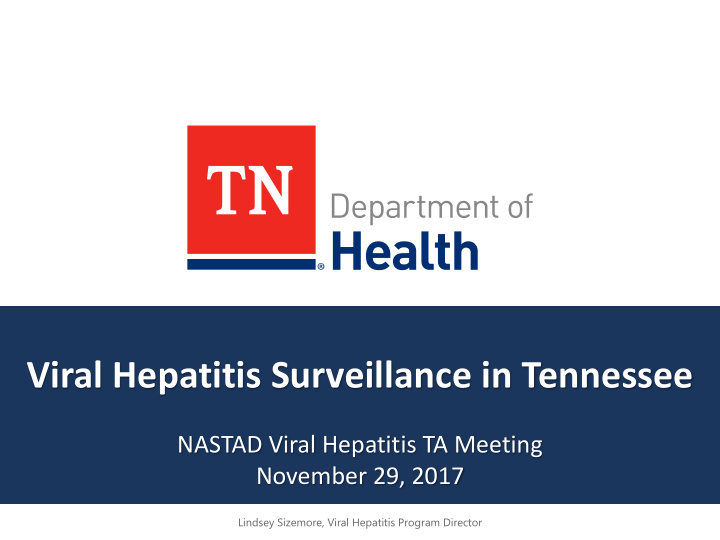



Viral Hepatitis Surveillance in Tennessee NASTAD Viral Hepatitis TA Meeting November 29, 2017 Lindsey Sizemore, Viral Hepatitis Program Director
Turning of The Tides
HIV Risk Vulnerability Assessment Webinar (CDC, September 2, 2015)
Vulnerability Assessment
Legislative Session, 2015
TDH VH Surveillance Program
VH Program at TDH • Formerly Housed in HAI • Integrated with HIV/STD Program, March 2015 – Prior to State Funding, Leveraged HIV Funds HIV/STD Epi Director Dr. Meredith Brantley
TN Public Health Regions
Surveillance Working Group Overview • Purpose – To elicit regional feedback on feasibility of VH surveillance • Central Office vs. Regional Responsibilities • Schedule – October 15, 2015 • Hepatitis Case Definitions • Developing Investigation Algorithms – October 22, 2015 • Reporting Requirements, Investigation Tools • New NBS Hepatitis Page Builder Pages – November 5, 2015 • NBS User Manual • Planning for In-Person Field Trainings
VH NBS User Guide • Purpose – To develop user-friendly, comprehensive, standardized VH reporting and investigation tools • Currently – Immunizations • HAV and Perinatal HBV – HIV/STD/VH • Non-Perinatal HBV and HCV
Field Investigation Tools Letters to Providers • – HBV/HCV Case Records Request (HBV and HCV) – Pregnancy Status Inquiry (HBV) – Public Health Authority Standardized Case Report Form (CRF) for HBV and HCV • – Case Report Details – Patient History – Contact Management – Education and Prevention • Note: NBS Page Builder Pages and CRF were synchronized – Case Classification Quick Reference Tables Pre and Post-Test Counseling • 2x2 Tables for Case Classification •
HBV Quick Reference Table https://wwwn.cdc.gov/nndss/conditions/hepatitis-b-acute/case-definition/2012/ https://wwwn.cdc.gov/nndss/conditions/hepatitis-b-chronic/case-definition/2012/
HBV Ab Quick Reference Table
Hepatitis C Quick Reference Table
Capacity to Conduct VH Surveillance Acute HBV and HCV • – All Clinically Suspected Cases – Field-investigated by Regions HBV-Positive Women of Reproductive Age (11-50) • – Evaluated for Pregnancy – Field-investigated by Regions Perinatal HBV • – Field-investigated by Regions Chronic HBV • – NBS-investigated by Regions Chronic HCV • – Lab Reportable 1/1/16 – Functionally • 1/1/17 – Lawfully • – NBS-investigated by Central Office
Centralized HCV Lab Processing Manually Received (Central Office, ~2,000/Month) • – If existing case • Associate labs and change case status, as needed – If not an existing case • Create investigation, assign case status, associate labs, and create CDC notification Electronically Received • – Regions mark as ‘reviewed’ (e.g. orphan) – Central Office responsibility (~3,000-5,000 per month) – If existing case • Associate labs and change case status, as needed – If not an existing case • Create investigation, assign case status, associate labs, and create CDC notification
VH Trainings and Monthly Calls • VH Surveillance Trainings – First Quarter 2016; In Person; All 13 Public Health Regions – Focused on New NBS Pages, Standardizing Investigations, and Case Definitions – Starting in 2017: Occur Every March or As Requested • VH Monthly Calls – 4 th Thursday of Each Month – Variety of Topics (i.e. Hierarchy of Field Investigations, HCV Testing Update, etc.)
Surveillance Data Snapshot: HBV • Acute (Confirmed Only) – 2013: 260 – 2014: 233 – 2015: 245 – 2016: 200 ( 23%) • Chronic (Confirmed Only) – 2013: 532 – 2014: 535 – 2015: 486 – 2016: 557 ( 5%)
Surveillance Data Snapshot: HCV • Acute (Confirmed Only) – 2013: 98 – 2014: 126 – 2015: 175 – 2016: 146 ( 49%) • Chronic (Confirmed Only) – 2013: 1,782 – 2014: 3,385 – 2015: 7,394 – 2016: 10,442 ( 486%)
Surveillance for Chronic HCV, Tennessee *Central Office Chronic HCV Surveillance Efforts Began On 7/1/15
Surveillance Projects
HCV High Risk Surveillance Overview Investigate newly reported positive HCV laboratory reports • received at TDH indicative of chronic HCV Focus on one group due to increase in HCV among women of • reproductive age and the potential for vertical transmission – 18-45 year old women – Excluding: • HBV co-infected • Anyone tested at a LHD (ordering and reporting provider) • Acute cases • NDR cases < 30 years old • Plasma and blood donation centers • Jails (either provider or patient address on lab) Conducted by Central Office staff •
HCV High Risk Surveillance Objectives • To assess pregnancy status from providers and to obtain additional risk factor information from patients • To provide education to infected individuals – Ab + • Referral to Health Department for RNA testing – RNA + • Referral to Viral Hepatitis Case Navigator
HCV High Risk Surveillance Results
HCV CBO Testing Program Overview • Rapid Antibody Test Kits Provided – CBOs serving at risk-populations – Currently 7 CBOs; 33% positivity rate
HCV CBO Testing Program Training Materials • Developed and Provided In-Person by Central Office Staff – Overview – Screening and Diagnosis – Device Training – Results and Messaging – Linkage to Care • Refer to LHD for Confirmatory Testing • Onboards New CBOs – Ongoing Quality Assurance – Refresher Every 2 Years
HCV CBO Testing Program Reporting Documents • Monthly Aggregate Spreadsheet – Total # Tests Conducted – # Positive – Aggregate Demographic and Risk Factor Information • CBO HCV Ab Testing Form (Positives Only) – In Lieu of PH-1600 – Person Level Data
Thank You!
Recommend
More recommend